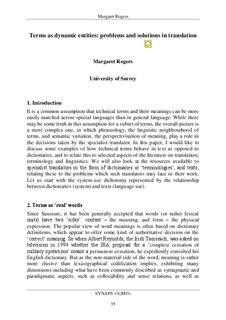| dc.description.abstract | It is a common assumption that technical terms and their meanings can be more
easily matched across special languages than in general language. While there
may be some truth in this assumption for a subset of terms, the overall picture is
a more complex one, in which phraseology, the linguistic neighbourhood of
terms, and semantic variation, the perspectivisation of meaning, play a role in
the decisions taken by the specialist translator. In this paper, I would like to
discuss some examples of how technical terms behave in text as opposed to
dictionaries, and to relate this to selected aspects of the literature on translation,
terminology and linguistics. We will also look at the resources available to
specialist translators in the form of dictionaries or ‘terminologies’, and texts,
relating these to the problems which such translators may face in their work.
Let us start with the system-use dichotomy represented by the relationship
between dictionaries (system) and texts (language use). | nb_NO |
